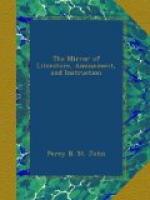Indeed, whosoever will take the trouble of comparing the two works which, turning upon nearly the same allegory, and bearing very similar titles, came into existence at or about the very same time, will plainly see their total dissimilarity. Bunyan’s is a close and continued allegory, in which the metaphorical fiction is sustained with all the minuteness of a real story. In Dr. Patrick’s the same plan is generally announced as arising from the earnest longing of a traveller, whom he calls Philotheus or Theophilus, whose desires are fixed on journeying to Jerusalem as a pilgrim. After much distressing uncertainty, caused by the contentions of pretended guides, who recommend different routes, he is at length recommended to a safe and intelligent one. Theophilus hastens to put himself under his pilotage, and the good man gives forth his instructions for the way, and in abundant detail, so that all the dangers of error and indifferent company may be securely avoided; but in all this, very little care is taken even to preserve the appearance of the allegory: in a word, you have, almost in plain terms, the moral and religious precepts necessary to be observed in the actual course of a moral and religious life. The pilgrim, indeed, sets out upon his journey, but it is only in order again to meet with his guide, who launches further into whole chapters of instructions, with scarcely a reply from the passive pupil. It is needless to point out the extreme difference between this strain of continued didactics, rather encumbered than enlivened by a starting metaphor, which, generally quite lost sight of, the author recollects every now and then, as if by accident—and the thoroughly life-like manner in which John Bunyan puts the adventures of his pilgrim before us. Two circumstances alone strike us as trenching somewhat on the manner of him of Elstow: the one is where the guide awakens some sluggish pilgrims, whom he finds sleeping by the way;[6] the other is where their way is crossed by two horsemen, who insist upon assuming the office of guide. ’The one is a pleasing talker, excellent company by reason of his pleasant humour, and of a carriage very pleasant and inviting; but they observed he had a sword by his side, and a pair of pistols before him, together with another instrument hanging at his belt, which was formed for pulling out of eyes.’[7] The pilgrims suspected this well-armed cavalier to be one of that brood who will force others into their own path, and then put out their eyes in case they should forsake it. They have not got rid of their dangerous companion, by whom the Romish church is indicated, when they are accosted by a man of a quite different shape and humour, ’more sad and melancholy, more rude, and of a heavier wit also, who crossed their way on the right-hand.’ He also (representing, doubtless, the Presbyterians or Sectaries) pressed them with eagerness to accept his guidance, and did little less than menace them with total destruction




